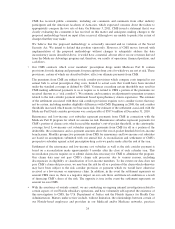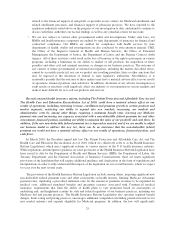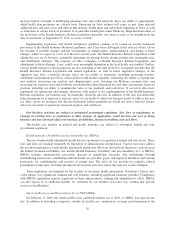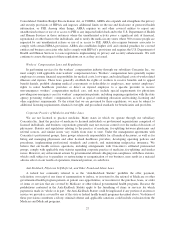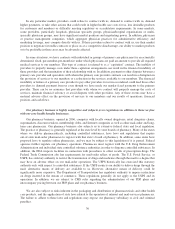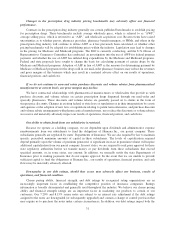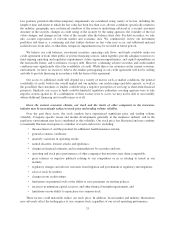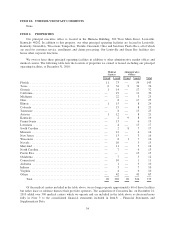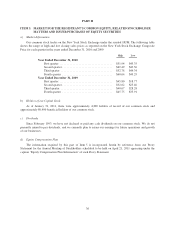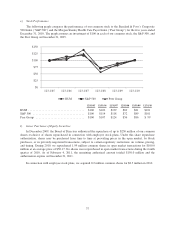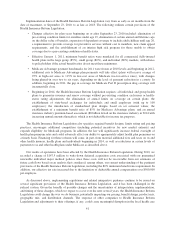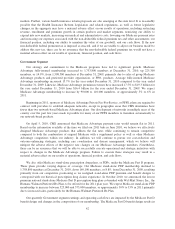Humana 2010 Annual Report Download - page 42
Download and view the complete annual report
Please find page 42 of the 2010 Humana annual report below. You can navigate through the pages in the report by either clicking on the pages listed below, or by using the keyword search tool below to find specific information within the annual report.cost and availability of future borrowings. Each of the rating agencies reviews its ratings periodically and there
can be no assurance that current ratings will be maintained in the future. Our ratings reflect each rating agency’s
opinion of our financial strength, operating performance, and ability to meet our debt obligations or obligations
to policyholders, but are not evaluations directed toward the protection of investors in our common stock and
should not be relied upon as such.
Historically, rating agencies take action to lower ratings due to, among other things, perceived concerns
about liquidity or solvency, the competitive environment in the insurance industry, the inherent uncertainty in
determining reserves for future claims, the outcome of pending litigation and regulatory investigations, and
possible changes in the methodology or criteria applied by the rating agencies. In addition, rating agencies have
come under recent regulatory and public scrutiny over the ratings assigned to various fixed-income products. As
a result, rating agencies may (i) become more conservative in their methodology and criteria, (ii) increase the
frequency or scope of their credit reviews, (iii) request additional information from the companies that they rate,
or (iv) adjust upward the capital and other requirements employed in the rating agency models for maintenance
of certain ratings levels.
We believe that some of our customers place importance on our credit ratings, and we may lose customers
and compete less successfully if our ratings were to be downgraded. In addition, our credit ratings affect our
ability to obtain investment capital on favorable terms. If our credit ratings were to be lowered, our cost of
borrowing likely would increase, our sales and earnings could decrease, and our results of operations, financial
position, and cash flows may be materially adversely affected.
Changes in economic conditions may adversely affect our results of operations, financial position, and
cash flows.
The U.S. economy continues to experience a period of slow economic growth and increased unemployment.
We have closely monitored the impact that this volatile economy is having on our Commercial segment
operations. Workforce reductions have caused corresponding membership losses in our fully-insured group
business. Continued weakness in the U.S. economy, and any resulting increases in unemployment, may
materially adversely affect our Commercial medical membership, results of operations, financial position, and
cash flows.
Additionally, the continued weakness of the U.S. economy has adversely affected the budget of individual
states and of the federal government. This could result in attempts to reduce payments in our federal and state
government health care coverage programs, including the Medicare, military services, and Medicaid programs,
and could result in an increase in taxes and assessments on our activities. Although we could attempt to mitigate
or cover our exposure from such increased costs through, among other things, increases in premiums, there can
be no assurance that we will be able to mitigate or cover all of such costs which may have a material adverse
effect on our results of operations, financial position, and cash flows.
In addition, general inflationary pressures may affect the costs of medical and other care, increasing the
costs of claims expenses submitted to us.
The securities and credit markets may experience volatility and disruption, which may adversely affect
our business.
Volatility or disruption in the securities and credit markets could impact our investment portfolio. We
evaluate our investment securities for impairment on a quarterly basis. This review is subjective and requires a
high degree of judgment. For the purpose of determining gross realized gains and losses, the cost of investment
securities sold is based upon specific identification. For debt securities held, we recognize an impairment loss in
income when the fair value of the debt security is less than the carrying value and we have the intent to sell the
debt security or it is more likely than not that we will be required to sell the debt security before recovery of our
amortized cost basis, or if a credit loss has occurred. When we do not intend to sell a security in an unrealized
32




